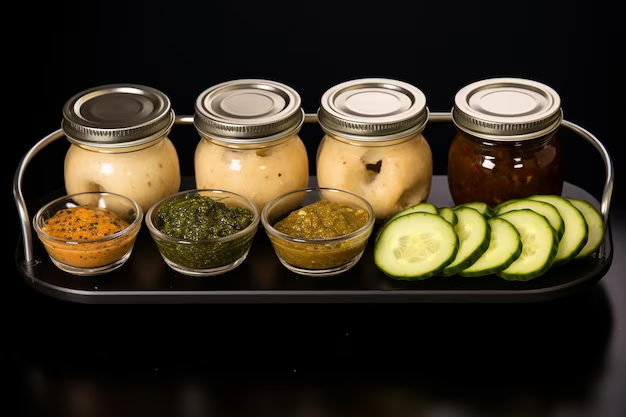Mustard Storage 101: Should You Keep It in the Refrigerator?
When you think of mustard, perhaps images of vibrant yellow dollops atop sizzling hot dogs or nestled in sandwiches come to mind. But once you've opened that tangy delight, where exactly should it live? Should it take residence in your refrigerator, or is it perfectly fine sitting in the pantry? This question reveals the deeper intricacies of condiment storage, which can affect flavor, safety, and the longevity of your food. Here’s a thorough guide on where to store mustard and why it matters.
🥪 The Basics of Mustard: What's Inside?
Before you can determine where to store mustard, it’s essential to understand what it's made of. Most mustard varieties, whether they lean towards the sharp Dijon or vibrant yellow, share common components:
- Mustard Seeds: Ground seeds from the mustard plant are the primary ingredient.
- Vinegar or Water: These liquids are used to create a smooth paste.
- Seasonings and Spices: Depending on the type, ingredients like salt, turmeric, and even sugar might be included.
The high vinegar content acts as a natural preservative, extending mustard's shelf life and adding complexity to its tangy flavor.
🧊 Is Refrigeration Necessary?
Upon popping open a new jar of mustard, a common question arises: should it be chilled? Here's a closer look at why many prefer the fridge over the pantry:
Preserving Flavor and Freshness
Flavor Retention: Refrigeration helps maintain the potency and sharpness of mustard flavors over time. Connoisseurs often find room-temperature mustard less zesty after extended periods.
Extended Shelf Life: While mustard does not typically spoil outside the refrigerator due to its acidity, storing it in the fridge can extend its freshness by preserving its flavor for longer durations.
Food Safety
Preventing Spoilage: Manufacture advice commonly leans towards refrigeration after opening to inhibit any potential microbial growth or spoilage, ensuring consumption safety across its use.
🌡️ When to Consider Room Temperature Storage
While chilling is generally preferred, some situations may allow for room-temperature storage:
- High Turnover Rate: If the household uses mustard frequently, the likelihood of degradation before use diminishes.
- Variety: Certain specialty mustards may indicate no need for refrigeration on their packaging—always check labels for specific instructions.
🥫 Exploring Different Mustard Types
Beyond the classic yellow and Dijon, a world of mustard varieties exists, each with unique storage considerations.
Dijon Mustard
Rich and creamy with a more sophisticated flavor profile, Dijon is often recommended for refrigeration to uphold its nuanced taste and creamy texture.
Yellow Mustard
The classic American favorite enjoyed for hot dogs and sandwiches. Given its more straightforward ingredient list, it holds up well without refrigeration, although chilling prolongs its vibrant color and piquancy.
Specialty Mustards
Gourmet options infused with ingredients like truffles or wines may have explicit manufacturer instructions on storage—best to follow these directives to preserve their delicate profile.
🍴 Practical Storage Considerations
Now that we know the "whys," let's explore practical storage tips:
Tips for Refrigerator Storage
- Dedicated Shelf or Section: Keeping mustards in the door compartment or a designated condiment area minimizes unnecessary moisture exposure and temperature fluctuations.
- Tight Lids: Ensure jars or bottles are securely sealed after each use to prevent air exposure, which can degrade flavor over time.
Tips for Pantry Storage
- Cool and Dark Environment: If opting for room temperature, choose a cool, dark place to prevent light or heat from compromising quality.
- Regular Check-ins: Keep an eye on texture changes or aroma shifts, which may indicate it's time to transfer to cooler storage.
📋 Visual Summary: Mustard Storage Tips
To keep these insights handy, here’s a succinct visual guide:
| 🏠 Storage Location | 🌡️ When to Store There | 🌟 Benefits |
|---|---|---|
| Refrigerator | Post-opening, especially for infrequent use or specialty mustards | Preserves flavor, prolongs shelf life, inhibits spoilage |
| Pantry | Unopened or frequent use | Maintains convenience, sufficient for short-term storage |
| Check Labels | Always, for specific instructions | Ensures manufacturer instructions are met for best results |
Exploring More: The Immense World of Condiments
Understandably, mustard isn't the only condiment that sparks debate on storage preferences.
Choosing the Right Storage for Other Condiments
- Ketchup: Often debated; refrigeration preserves its vibrant red hue and texture.
- Mayonnaise: Always chilled to secure safety and texture.
- Soy Sauce: While its high sodium content does well at room temperature, chilling can enhance longevity.
🤔 Making Your Decision
Ultimately, the choice between the fridge and pantry may depend on personal preference for mustard's top-notch taste or sheer convenience. When strategically placed in a refrigerator, mustard maintains its vibrant taste and color longer, but it’s more than adequate to keep at room temperature in many situations.
Every home is different, and your storage needs may evolve. By understanding what impacts mustard's freshness and flavor, you’re empowered to make informed decisions that work best for you.
Delve into your tastes and consider mustard's role in your culinary world—whether as an occasional accompaniment or a daily delight. Ultimately, understanding mustard's edible lifespan helps in making better decisions for storage, contributing to better food experiences and less waste.
In short, keep mustard the way you enjoy it most and tailor storage to your lifestyle or taste preferences. 😊
